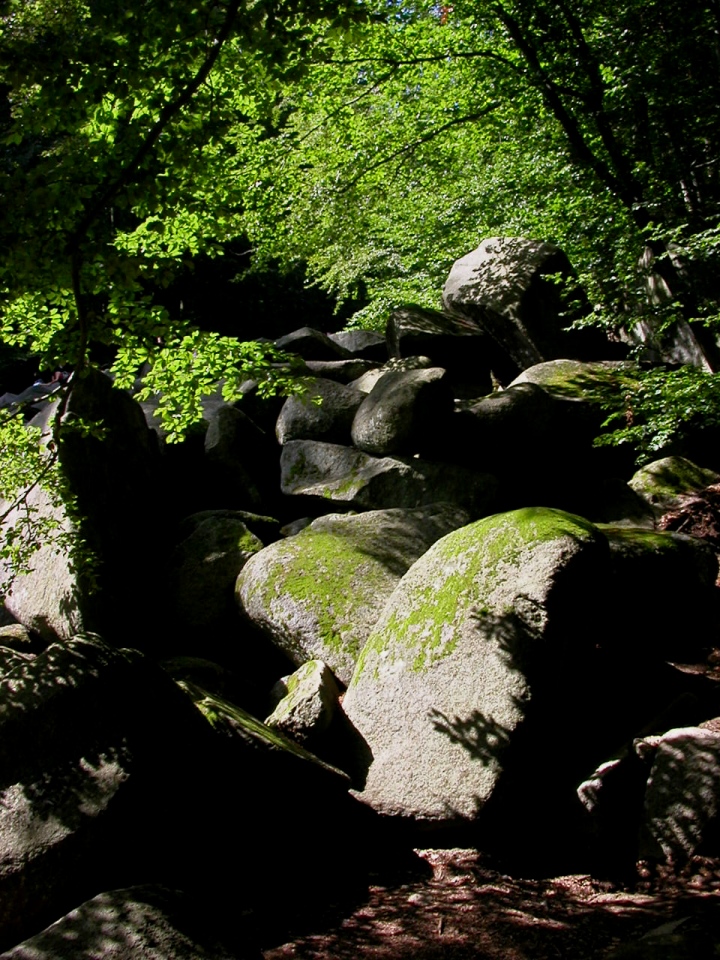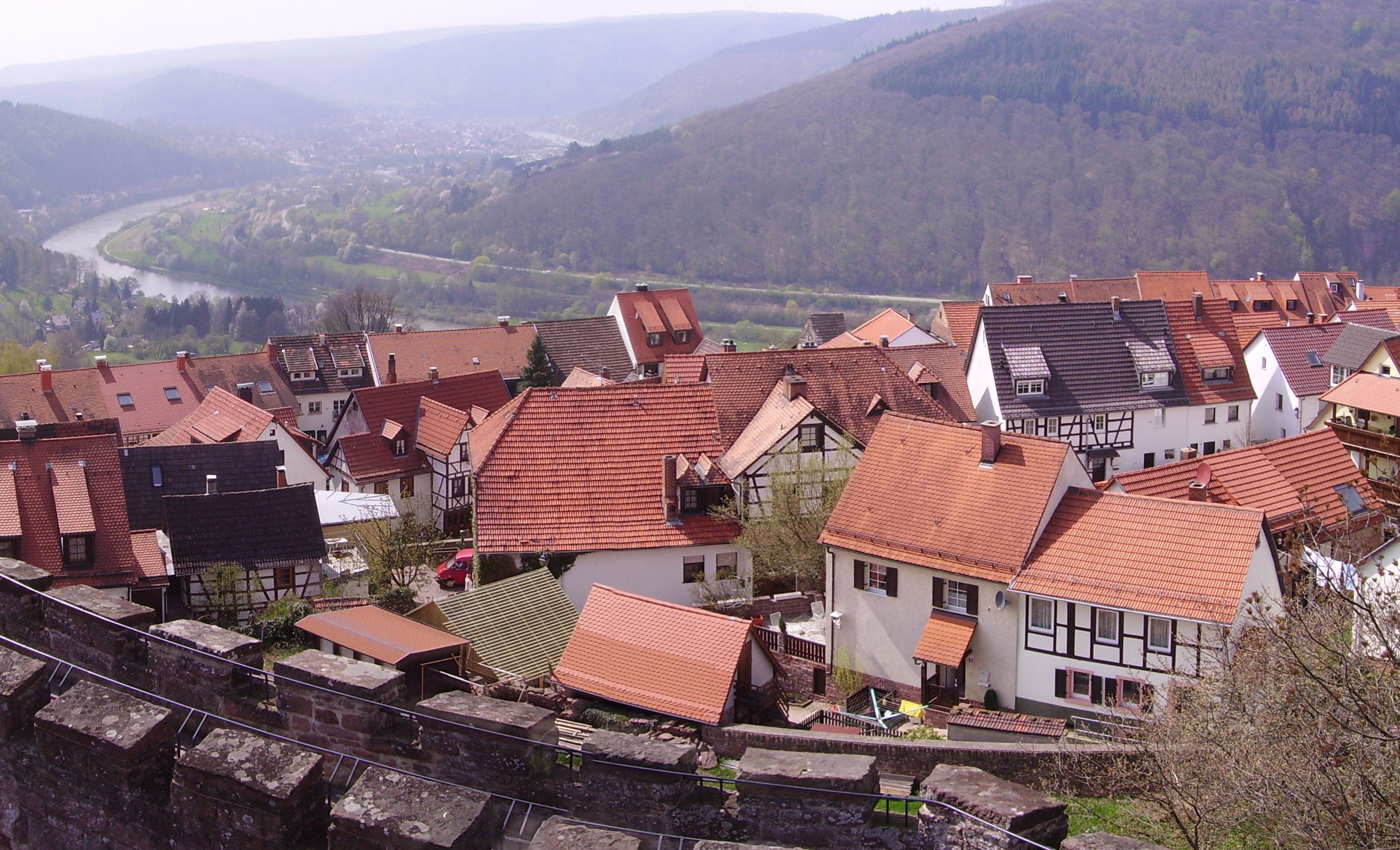|
Hesseneck
Hesseneck is a village and a former municipality in the Odenwaldkreis (district) in Hesse, Germany. With only just over 600 inhabitants, Hesseneck was Hesse’s smallest self-governing community. Since January 2018, it is part of the new town Oberzent. Geography Location The community lies in the southern Odenwald at the foot of the Krähberg at elevations of 230 to 500 m. It lies at the three-state common point shared by Hesse, Bavaria and Baden-Württemberg. The community's name itself means "Hesse Corner". The outlying centre of Hesselbach has no road link to Hessian territory and can only be reached through Baden-Württemberg. Neighbouring communities Hesseneck borders in the north on the towns of Beerfelden and Erbach (both in the Odenwaldkreis) as well as the market town of Kirchzell ( Miltenberg district in Bavaria), in the east on the community of Mudau (Neckar-Odenwald-Kreis in Baden-Württemberg), in the south on the town of Eberbach (Rhein-Neckar-Kreis in Bade ... [...More Info...] [...Related Items...] OR: [Wikipedia] [Google] [Baidu] |
Beerfelden
Beerfelden (pronunciation: ˈbeːɐˌfɛldən) was a town in the Odenwald in the Odenwaldkreis (district) in Hesse, Germany, 28 km northeast of Heidelberg. On 1 January 2018 Beerfelden, Hesseneck, Rothenberg and Sensbachtal merged to create the town Oberzent. Geography Location Beerfelden lies in the Odenwald at elevations from 330 to 540 m. Towards the south stretches the narrow, wooded Gammelsbach Valley, in which are found the Freienstein castle ruins, down to the Neckar. The ''Beerfelder Land'' is a tourist region that lies between Beerfelden, the communities of Rothenberg, Sensbachtal and Hesseneck in the ''Geo-Naturpark Bergstraße-Odenwald'' and which is one of the Odenwald's most richly forested areas. The ''Beerfelder Land'' lies at elevations from 200 to 555 m above sea level. Within it is the 626 m-high Katzenbuckel near Waldkatzenbach, which is part of a chain of heights running north-south. To the east stands the Krähberg hunting castle ( ... [...More Info...] [...Related Items...] OR: [Wikipedia] [Google] [Baidu] |
Oberzent
Oberzent is a town in the district of Odenwaldkreis, in Hesse, Germany. It was created with effect from 1 January 2018 by the merger of the former town Beerfelden and the former municipalities of Hesseneck, Rothenberg and Sensbachtal. Geography Neighbouring communities Oberzent borders in the north on the municipality of Mossautal, the town of Erbach and the municipality of Kirchzell ( Miltenberg district in Bavaria), in the east on the municipality of Mudau (Neckar-Odenwald-Kreis in Baden-Württemberg), in the south on the towns of Eberbach (Rhein-Neckar-Kreis in Baden-Württemberg) and Hirschhorn (Neckar) ( Kreis Bergstraße) and in the west on the municipality of Wald-Michelbach (Kreis Bergstraße). Constituent communities Oberzent’s 19 quarters are Airlenbach, Beerfelden, Etzean, Falken-Gesäß, Finkenbach, Gammelsbach, Hebstahl, Hesselbach, Hetzbach, Hinterbach, Kailbach, Kortelshütte, Ober-Hainbrunn, Ober-Sensbach, Olfen, Raubach, Rothenberg Rothenberg is a village ... [...More Info...] [...Related Items...] OR: [Wikipedia] [Google] [Baidu] |
Eberbach (Baden)
Eberbach (; South Franconian: ''Ewwerbach'') is a town in Germany, in northern Baden-Württemberg, located 33 km east of Heidelberg. It belongs to the Rhein-Neckar-Kreis. Its sister cities are Ephrata, United States and Thonon-les-Bains, France. Geography Location Eberbach lies at the foot of the Katzenbuckel, at 626 m the highest elevation in the Odenwald, in the ''Naturpark Neckartal-Odenwald'', on the romantic ''Burgenstraße'' (Castle Road) along the river Neckar. Boroughs Eberbach includes the boroughs of Neckarwimmersbach, Brombach, Friedrichsdorf, Lindach, Rockenau, Badisch Igelsbach, Gaimühle, Unterdielbach, Badisch Schöllenbach and Pleutersbach. The border with Hesse runs through the borough of Igelsbach. Therefore, only the northeast half, called ''Badisch Igelsbach'', of the borough belongs to Eberbach. The southwest half, called ''Hessisch Igelsbach'', belongs to the Hessian municipality of Hirschhorn. The same is true for the borough Schöllenbach. T ... [...More Info...] [...Related Items...] OR: [Wikipedia] [Google] [Baidu] |
Odenwald
The Odenwald () is a low mountain range in the German states of Hesse, Bavaria and Baden-Württemberg. Location The Odenwald is located between the Upper Rhine Plain with the Bergstraße and the ''Hessisches Ried'' (the northeastern section of the Rhine rift) to the west, the Main and the Bauland (a mostly unwooded area with good soils) to the east, the Hanau-Seligenstadt Basin – a subbasin of the Upper Rhine Rift Valley in the Rhine-Main Lowlands – to the north and the Kraichgau to the south. The part south of the Neckar valley is sometimes called the ''Kleiner Odenwald'' ("Little Odenwald"). The northern and western Odenwald belong to southern Hesse, with the south stretching into Baden. In the northeast, a small part lies in Lower Franconia in Bavaria. Geology The Odenwald, along with other parts of the Central German Uplands, belongs to the Variscan, which more than 300 million years ago in the Carboniferous period ran through great parts of Europe. The cause ... [...More Info...] [...Related Items...] OR: [Wikipedia] [Google] [Baidu] |
Erbach (Odenwald)
Erbach () is a town and the district seat of the Odenwaldkreis (district) in Hesse, Germany. It has a population of around 13,000. Geography Location The town lies in the ''Mittelgebirge'' Odenwald at elevations between 200 and 560 m in the valley of the Mümling. One geological peculiarity is the creek Erdbach's complete disappearance within Dorf-Erbach's community area. The Erdbach reappears near Stockheim. There are several places where the Erdbach disappears into the ground. Neighbouring communities Erbach borders in the north on the town of Michelstadt, in the east on the market town of Kirchzell (in Miltenberg district in Bavaria), in the south on the community of Hesseneck and the town of Beerfelden and in the west on the community of Mossautal (all three in the ''Odenwaldkreis''). A planned merger with the neighbouring town of Michelstadt was blocked in November 2007 by a referendum (''Bürgerentscheid''). For the time being, ways are being sought to deepen the t ... [...More Info...] [...Related Items...] OR: [Wikipedia] [Google] [Baidu] |
Sensbachtal
Sensbachtal is a village and a former municipality in the Odenwaldkreis (district) in Hesse, Germany. Since January 2018, it is part of the new town Oberzent. Geography Location Sensbachtal lies in the southern Odenwald and the ''Geo-Naturpark Bergstraße-Odenwald'' at elevations of between 300 and 550 m, 10 km away from Eberbach on the Neckar. Neighbouring communities Sensbachtal borders in the east on the community of Hesseneck (Odenwaldkreis), in the south on the town of Eberbach (Rhein-Neckar-Kreis in Baden-Württemberg) and in the west and north on the town of Beerfelden (Odenwaldkreis). Constituent communities Sensbachtal’s ''Ortsteile'' are Hebstahl, Ober-Sensbach and Unter-Sensbach. Politics The municipal election held on 26 March 2006 yielded the following results: The municipal council is thereby made up exclusively of non-party voter communities. In Hesse, this is otherwise only the case in the community of Antrifttal (Vogelsbergkreis). Mayor Egon Sc ... [...More Info...] [...Related Items...] OR: [Wikipedia] [Google] [Baidu] |
Bundesstraße
''Bundesstraße'' (German for "federal highway"), abbreviated ''B'', is the denotation for German and Austrian national highways. Germany Germany's ''Bundesstraßen'' network has a total length of about 40,000 km. German ''Bundesstraßen'' are labelled with rectangular yellow signs with black numerals, as opposed to the white-on-blue markers of the ''Autobahn'' controlled-access highways. ''Bundesstraßen'', like autobahns, are maintained by the federal agency of the Transport Ministry. In the German highway system they rank below autobahns, but above the ''Landesstraßen'' and ''Kreisstraßen'' maintained by the federal states and the districts respectively. The numbering was implemented by law in 1932 and has overall been retained up to today, except for those roads located in the former eastern territories of Germany. One distinguishing characteristic between German ''Bundesstraßen'' and ''Autobahnen'' is that there usually is a general 100 km/h (62 mph) s ... [...More Info...] [...Related Items...] OR: [Wikipedia] [Google] [Baidu] |
Railway
Rail transport (also known as train transport) is a means of transport that transfers passengers and goods on wheeled vehicles running on rails, which are incorporated in tracks. In contrast to road transport, where the vehicles run on a prepared flat surface, rail vehicles (rolling stock) are directionally guided by the tracks on which they run. Tracks usually consist of steel rails, installed on sleepers (ties) set in ballast, on which the rolling stock, usually fitted with metal wheels, moves. Other variations are also possible, such as "slab track", in which the rails are fastened to a concrete foundation resting on a prepared subsurface. Rolling stock in a rail transport system generally encounters lower frictional resistance than rubber-tyred road vehicles, so passenger and freight cars (carriages and wagons) can be coupled into longer trains. The operation is carried out by a railway company, providing transport between train stations or freight customer facilit ... [...More Info...] [...Related Items...] OR: [Wikipedia] [Google] [Baidu] |
Castra
In the Roman Republic and the Roman Empire, the Latin word ''castrum'', plural ''castra'', was a military-related term. In Latin usage, the singular form ''castrum'' meant 'fort', while the plural form ''castra'' meant 'camp'. The singular and plural forms could refer in Latin to either a building or plot of land, used as a fortified military base.. Included is a discussion about the typologies of Roman fortifications. In English usage, ''castrum'' commonly translates to "Roman fort", "Roman camp" and "Roman fortress". However, scholastic convention tends to translate ''castrum'' as "fort", "camp", "marching camp" or "fortress". Romans used the term ''castrum'' for different sizes of camps – including large legionary fortresses, smaller forts for cohorts or for auxiliary forces, temporary encampments, and "marching" forts. The diminutive form ''castellum'' was used for fortlets, typically occupied by a detachment of a cohort or a '' centuria''. For a list of known castr ... [...More Info...] [...Related Items...] OR: [Wikipedia] [Google] [Baidu] |
Neckar-Odenwald Limes
The Neckar-Odenwald Limes (german: Neckar-Odenwald-Limes) is a collective term for two, very different early sections of the Upper Germanic-Rhaetian Limes, a Roman defensive frontier line that may have been utilised during slightly different periods in history. The Neckar-Odenwald Limes consists of the northern Odenwald Limes (''Odenwaldlimes''), a cross-country ''limes'' with camps, watchtowers and palisades, which linked the River Main (Latin: ''Moenus'') with the Neckar (Latin: ''Nicer''), and the adjoining southern Neckar Limes (''Neckarlimes''), which in earlier research was seen as a typical 'riverine limes' (German: ''Nasser Limes''; Latin: ''limes ripa''), whereby the river replaced the function of the palisade as an approach obstacle. More recent research has thrown a different light on this way of viewing things that means may have to be relativized in future.Stephan Bender: Unser Bild vom Neckarlimes: bald nur noch Geschichte?(pdf; 6.0 MB).'' In: ''Archäologie in De ... [...More Info...] [...Related Items...] OR: [Wikipedia] [Google] [Baidu] |
Rhein-Neckar-Kreis
The Rhein-Neckar-Kreis is a district in the northwest of Baden-Württemberg, Germany. The administrative headquarters are based in the city Heidelberg, which is a district-free city. As of 2019, the district is the most populous in Baden-Württemberg. History The district was created in 1973 by merging the previous districts of Heidelberg, Mannheim and Sinsheim. Geography The district is named after the two main rivers which flow through the district, the Rhine and Neckar. The highest elevation is 580 m near the 584 m tall peak of the Odenwald mountain Stiefelhöhe, located near Heiligkreuzsteinach. The lowest elevation with 92 m is in Ilvesheim, located in the Neckar valley. Sights Government The district is governed by a district assembly (''Kreistag'') and a district executive (''Landrat''). The eligible voters of the district elect the Kreistag every 5 years. This body in turn elects the Landrat every 8 years. The Landrat is the legal representative of the district as wel ... [...More Info...] [...Related Items...] OR: [Wikipedia] [Google] [Baidu] |






